
How Ransomware Attacks Are Evolving and How to Stay Protected
January 8, 2024
The threat of ransomware attacks is continually evolving, posing significant risks to businesses worldwide. Understanding the changing tactics of ransomware perpetrators is crucial for businesses of all size aiming to fortify their defenses against these malicious attacks.
The Changing Landscape of Ransomware
Ransomware 101: Understanding the Digital Menace
In the perilous landscape of ransomware threats, ransomware stands tall as a formidable adversary. Picture a digital hostage situation where malicious software infiltrates systems, encrypts crucial data, and holds it captive until a ransom is paid. This software, like a digital highway robber, penetrates networks, stealthily locking away access to vital files, systems, and sometimes even entire databases. Its impact extends beyond mere data encryption, often paralyzing operations and throwing businesses into a tailspin. From large enterprises to small businesses, ransomware does not discriminate. In fact, the majority of ransomware attacks target small businesses and 60% of them close within 6 months of a breach.
The sophistication of these attacks evolves incessantly, making ransomware a formidable foe for businesses and underscoring the urgency of proactive defense measures in 2024 and beyond.
Trends in Ransomware: The Ever-Changing Face of Cyber Extortion
Ransomware, much like a shape-shifter in the digital realm, evolves relentlessly., unveiling new tactics and techniques to infiltrate vulnerable systems. Recent trends illuminate a concerning escalation in ransomware sophistication. Cybercriminals pivot towards targeted attacks, favoring quality over quantity, aiming their malicious codes at high-value targets such as large enterprises, critical infrastructure, or very often small third-party vendors who are linked to the prized targets. In recent years, we’ve been hearing a lot about supply-chain attacks, with the SolarWind breach being among the most famous. According to Business Insider, as many as 18,000 of SolarWind’s customers were placed in jeopardy by a malicious software update, including Fortune 500 firms and U.S. government agencies. The evolution continues with double-extortion tactics – first encrypting data and then threatening to leak sensitive information if ransom demands are not met. This trend amplifies the financial and reputational risks for organizations, intensifying the already dire consequences of ransomware attacks. Furthermore, the rise of ransomware-as-a-service (RaaS) models enables even non-technical individuals to initiate ransomware campaigns, expanding the threat landscape exponentially.
As mentioned, ransomware does not discriminate based on the size of an organization, but trends show it does favor certain industries. Manufacturing replaced financial services and the prime target of ransomware in 2021, and attacks increased against law firms and municipalities in 2023 according to the Q3 Ransomware Report by Corvus Insurance.
Sophistication and Variants
The realm of ransomware exhibits an ever-increasing sophistication in its variants and tactics, marking a concerning trend in the cyber threat landscape. As mentioned in a recent article on BleepingComputer, a joint Cybersecurity Advisory from government agencies in the U.S. and Australia, and published by the Cybersecurity and Infrastructure Security Agency (CISA,) is warning organizations of the latest tactics, techniques, and procedures (TTPs) used by the BianLian ransomware group. BianLian is a ransomware and data extortion group that has been targeting entities in the U.S. and Australian critical infrastructure since June 2022. BianLian used a double-extortion model, which has become more prevalent in recent years, encrypting systems after stealing private data from victim networks, and then threatening to publish the files. This is just one example of some of the sophisticated variants seen in recent years.
Another variant in addition to the double-extortion model is the use of dockware or leakware. According to Crowdstrike, “Leakware threatens to distribute sensitive personal or company information online, and many people panic and pay the ransom to prevent private data from falling into the wrong hands or entering the public domain. One variation is police-themed ransomware, which claims to be law enforcement and warns that illegal online activity has been detected, but jail time can be avoided by paying a fine.”
These variants adapt rapidly, evading traditional security measures and exploiting vulnerabilities in diverse systems. The evolution towards more complex and stealthy ransomware strains poses a significant challenge for businesses striving to defend their digital assets against these relentless threats. As cybercriminals intensify their efforts to infiltrate and extort, staying informed about these evolving variants becomes imperative for businesses seeking to fortify their defenses and safeguard their data from the ever-evolving ransomware menace.
Strategies for Ransomware Protection
Data Backup and Recovery
Data backup and recovery serve as a critical fortress against the onslaught of ransomware attacks, providing a shield for businesses’ digital assets. Employing a meticulous backup strategy involves creating regular, secure copies of crucial data and storing them in isolated, offsite locations. This strategy, often utilizing incremental or differential backups, ensures that even if ransomware encrypts or compromises primary data, the unaltered backup copies remain unaffected and accessible. Employing a combination of full, incremental, and differential backups enhances data redundancy, enabling organizations to restore their systems to a pre-attack state. Implementing a robust recovery plan that includes detailed procedures for data restoration and system reconfiguration enhances the effectiveness of data backup and a defense mechanism against ransomware.

Employee Training and Awareness
Employee training and awareness constitute the frontline defense in safeguarding businesses against ransomware attacks. Educating employees about the nuances of ransomware threats, including recognizing suspicious emails, links, or attachments, forms a crucial pillar of defense. Comprehensive training programs, encompassing simulated phishing exercises and interactive sessions, empower employees to identify and report potential threats effectively. Cultivating a culture of cybersecurity awareness fosters a vigilant workforce that becomes an active line of defense against ransomware attacks. Moreover, continually reinforcing best practices and security protocols ensures that employees remain updated and equipped to thwart evolving ransomware tactics, significantly reducing the risk of successful attacks.
Patch Management and Software Updates
Patch management and software updates serve as pivotal measures in fortifying defenses against ransomware attacks. Timely application of security patches, software updates, and system upgrades helps mitigate vulnerabilities that ransomware often exploits. Robust patch management protocols involve regularly monitoring for security updates released by software vendors and promptly applying these patches to close potential entry points for ransomware. Additionally, automating patch deployment streamlines the process, ensuring that systems remain fortified against known vulnerabilities. Instituting a proactive approach to software updates and patch management becomes indispensable in bolstering the resilience of organizational systems and minimizing the risk of ransomware.
Implementing Robust Security Measures
Implementing security measures like network segmentation and access control forms a cornerstone of ransomware defense strategies. Network segmentation involves dividing an organization’s network into smaller, isolated segments, creating barriers that limit lateral movement in the event of a ransomware breach. This isolation impedes the spread of ransomware across the entire network, confining its impact to a specific segment, thereby reducing the scope of potential damage. Concurrently, enforcing stringent access controls, including least privilege principles, restricts unauthorized access to critical systems and data. By implementing these measures, organizations can erect formidable barriers against ransomware attacks, mitigating their impact and thwarting attempts at widespread infiltration.
Incident Response Planning
The plan your organization develops for incident response is crucial in mitigating the fallout of ransomware attacks. It is often said that it is not a matter of if, but rather of when, many organizations will face a ransomware attack. An effective incident response plan maps out detailed procedures for swift identification, containment, eradication, and recovery from ransomware incidents. Equally important is a robust communication strategy encompassing clear protocols for internal and external notifications, ensuring transparency and alignment across the organization. Simultaneously, a well-crafted PR plan orchestrates a cohesive and proactive approach to managing external communications, safeguarding the organization’s reputation, and assuring stakeholders amidst the aftermath of an incident. These strategies will not only expedite recovery but also demonstrate organizational preparedness, instilling confidence and trust with stakeholders.
Conclusion
Partnering with a managed security services provider (MSSP), like BCS365, offers businesses a proactive shield against the looming threat of ransomware attacks. These specialized providers boast in-depth expertise, cutting-edge technologies that might be cost-prohibitive for individual use, and a comprehensive suite of tools specifically designed to combat evolving cyber threats like ransomware. By entrusting the defense of your critical assets to experts like us, businesses gain access to 24/7/365 monitoring, rapid threat detection, and swift response mechanisms. With a managed security partner at their side, businesses can navigate the landscape with fortified resilience, allowing them to focus on core objectives and stand strong against evolving ransomware threats.




